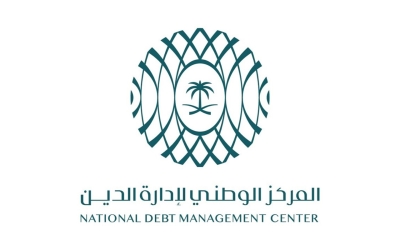
The Kingdom of Saudi Arabia's external debt, or foreign debt, is one of the means of providing liquidity and constitutes part of the country's total public debt, alongside domestic public debt. It is the total of the bonds owned by parties outside the country, such as foreign governments, individuals outside the nation's borders, and international organizations.
Through cash surpluses and reducing the budget deficit, the Kingdom managed to decrease the debt size from 2005 to 2014. In 2011, the debt amounted to 5.4 percent of the gross domestic product (GDP), and the following year, the Kingdom became the third least indebted country in the world, with a debt-to-GDP ratio of 3 percent. The debt continued to decline, reaching 1.6 percent of GDP in 2014.
The sharp decline in oil prices in 2015 contributed to an increase in the budget deficit, reaching SAR388 billion, which led to a rise in the public debt-to-GDP ratio to 5.8 percent. As of December 31, 2015, the government’s outstanding debt amounted to SAR142.2 billion (USD37.9 billion), all of which were domestic debts.
External debt movement
External debt appeared in the budget data prepared by the Ministry of Finance in 2016. As of December 31, 2016, the government's outstanding direct external debt amounted to SAR103.1 billion (USD27.5 billion) and increased further to SAR183.8 billion (USD49 billion) by December 31, 2017.
With the continued decline in oil prices and the increasing budget deficit, the government's outstanding direct external debt rose to SAR255 billion (USD68 billion) by December 31, 2018. It continued to rise, reaching SAR305.2 billion (USD81.4 billion) by December 31, 2019, and further increasing to SAR350.2 billion (USD93.4 billion) by September 2020.
External debt also increased in September 2021, reaching SAR387.6 billion (USD103.4 billion), before decreasing to SAR379.3 billion (USD 101.1 billion) by December 2021, and further declining to SAR 375.1 billion (USD100 billion) by December 2022.
In December 2023, external debt rose again, reaching SAR405.9 billion (USD108.2 billion). By June 2024, the Saudi government's external debt reached approximately SAR468.9 billion (USD125.0 billion).
Public debt portfolio
Regarding the public debt portfolio, its size increased by SAR176 billion in 2020, representing a 26 percent rise, with total financing operations amounting to approximately SAR220 billion. This included international financing of around SAR46 billion, along with diversification of financing sources both locally and internationally across the entire portfolio.
The financial performance adhered to a balanced policy amid declining demand and oil prices due to the COVID-19 pandemic. In 2020, the Kingdom participated twice in international debt markets. In January, the government achieved its lowest-ever yield from an issuance, while the April issuance saw the highest demand in emerging markets with a coverage ratio of 7.7 times. The Kingdom also extended its international yield curve by issuing thirty-five-year and forty-year bonds for the first time.
In 2021, the public debt portfolio increased by approximately SAR85 billion, reaching SAR938 billion, equivalent to 30.0 percent of the GDP. In 2022, the portfolio grew by SAR52 billion, bringing the total to SAR990 billion, or 25.0 percent of GDP. The rise in the portfolio size was due to proactive financing operations aimed at managing refinancing risks amidst rising interest rates. In 2023, the public debt portfolio further increased by SAR60 billion, reaching SAR 1,050 billion, which accounted for 25.4 percent of GDP.
International debt portfolio
According to the procedures and policies of the National Debt Management Center, the current and projected international debt portfolio carries limited risk related to foreign exchange rate fluctuations, given the Kingdom's strong foreign currency reserves, asset positions, and stable exchange rate policy. By the end of 2020, euro-denominated debt represented less than 1.5 percent of the total debt portfolio. Approximately 2 percent of the total debt portfolio was recorded at the end of 2021, with the same percentage at the end of 2022 and 2023.
Diversification of local and international issuances
To achieve greater fiscal discipline in public finances, the public debt strategy began to rely on diversifying issuances between local and international markets by issuing sukuk and bonds with various maturities, ranging from short to medium and long-term.
In the 2018 state budget, the Ministry of Finance adopted a balanced policy between debt issuances and withdrawals from government deposits and the state's general reserves to finance the budget deficit. It also diversified its local and international issuances by issuing sukuk and bonds amounting to approximately SAR134 billion, including around SAR33.7 billion in external sukuk and SAR46.8 billion in external bonds.
In 2017, the National Debt Management Center (formerly the Public Debt Management Office) organized an international sukuk program and launched the largest sovereign sukuk issuance in emerging markets in April, which exceeded the previous largest sovereign sukuk issuance in the world by more than double.
The issuance amounted to USD9 billion and was formed of two segments: a segment for five years of USD4.5 billion whose due date was April 20, 2022, and a return of 2.894 percent per year at the time of its issuance. The second segment is for ten years and amounts to USD4.5 billion; its due date is April 20, 2027, with a return of 3.628 percent per year at the time of its issuance.
The Ministry of Finance, through the National Debt Management Center, continued to raise funds by issuing bonds. In September 2017, it successfully managed the second international bond issuance, amounting to USD12.5 billion across three tranches. The first tranche was USD3 billion with a five-year maturity, due on March 4, 2023, with an annual yield of 3.009 percent at the time of issuance. The second tranche amounted to USD5 billion with a ten-year maturity, due on March 4, 2028, with an annual yield of 3.762 percent at the time of issuance. The third tranche was USD4.5 billion, maturing on October 4, 2047, with an annual yield of 4.663 percent at the time of issuance.
Saudi monetary policy
The monetary policies implemented by the Kingdom have contributed to enhancing monetary and financial stability, earning the confidence of international investors. As a result, in March 2018, the Public Debt Management Office (now the National Debt Management Center) received approval from the group of financial institutions participating in the syndicated loan on the terms it proposed. This marked another success for the center in amending, repricing, and extending the term of the Kingdom's international syndicated loan, initially arranged in 2016, amounting to USD10 billion.
Based on the Kingdom's strong financial position and robust economy, demand for investment in both local and international debt issuances more than tripled during the first half of 2019. The first euro-denominated issuance exceeded the expected subscription by over four times. Additionally, the nominal value of government sukuk was reduced to SAR1,000 to diversify the investor base, enhance trading, and promote individual savings.
In 2020, there was an increase in announced debt issuances, reaching an additional SAR100 billion on top of the previously announced SAR120 billion, bringing the total to SAR220 billion. The second issuance of debt instruments in the international market that year saw significant demand, further strengthening the Kingdom's credit position and confirming the robustness of its financial standing.
Development in debt management
The successful execution of the plans and strategies of the Financial Balance Program (later the Fiscal Sustainability Program) and the Financial Sector Development Program led to significant progress in debt management. The second euro-denominated international issuance from the Kingdom's bond program was closed in February 2021 in a record time of just one day.
This operation represented an ideal opportunity to enter the euro market (the second-largest market after the U.S. dollar) by issuing debt instruments with a negative yield, making it the largest negative-yield issuance outside the European Union. Approximately EUR1.5 billion was raised from subscriptions. It was the second international issuance in 2021, following the Kingdom's USD5 billion issuance in January of the same year.
As part of the National Debt Management Center's arrangement for the first partial repurchase of the Kingdom's dollar-denominated bonds and the issuance of dollar-denominated sukuk and bonds split into two tranches maturing in 2028 and 2032, with a total value of USD5 billion, the first partial repurchase of dollar-denominated bonds maturing in 2023, 2025, and 2026 was completed in 2022, with a total value of USD1.3 billion (approximately SAR4.8 billion), and new dollar bonds were issued in exchange. Additionally, a local repurchase operation worth more than SAR26 billion was completed, where debt instruments maturing in 2023, 2024, and 2026 were settled, and sukuk were issued in return.
In 2023, the National Debt Management Center completed a local repurchase operation valued at approximately SAR36 billion. Debt instruments maturing in 2024, 2025, and 2026 were settled, and sukuk were issued in return. This contributed to an increase in the average maturity of the debt portfolio and reduced refinancing risks for the coming years.
Related quizzes
Related articles

